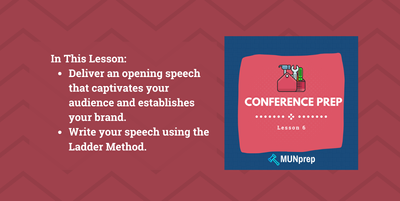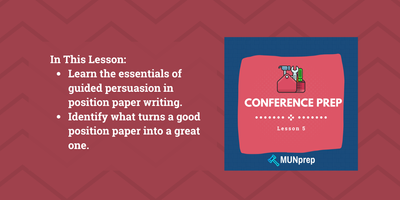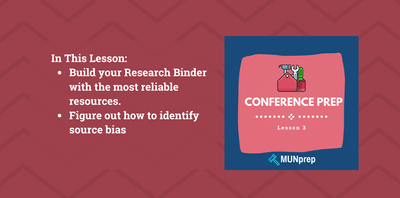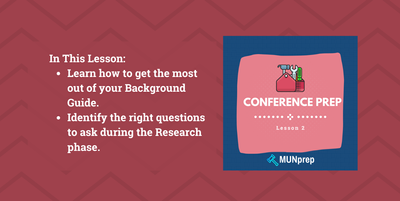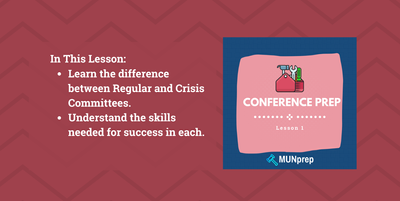Model UN Problem-Solving - Turning Ideas into Policy Proposals
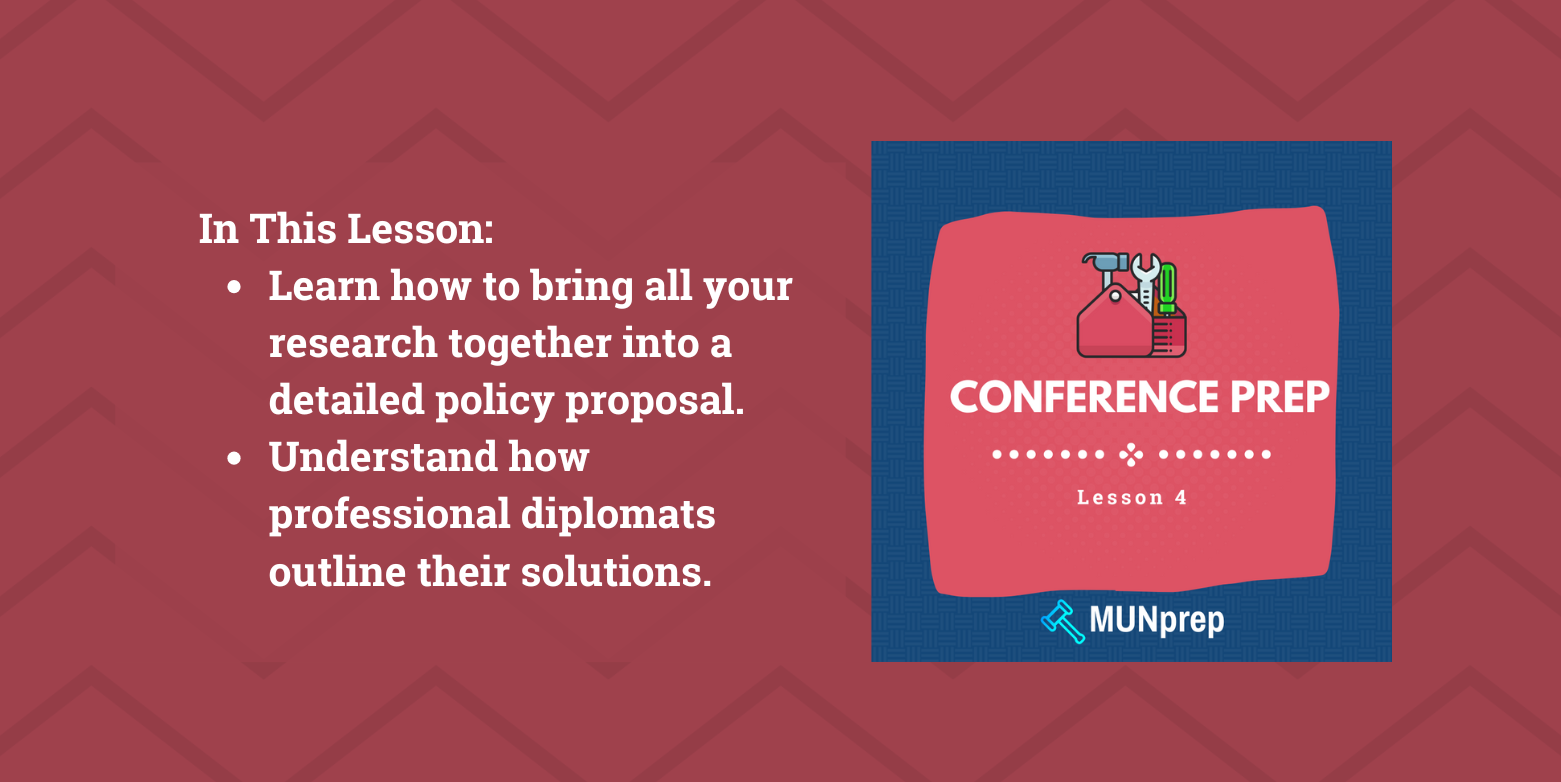
By now, you’ve conducted your research, and brainstormed creative solutions. Up next, it's time to turn those solutions into policy proposals that you can pitch to delegates during a conference. This process requires some careful consideration - but don't worry! We're here to help.
Today, we're going to help you test your ideas, and show you how to refine them into workable strategies, by the end of this guide, they will be packaged and ready for other delegates to understand—and hopefully support.
Laying the Groundwork
Your solutions are the backbone of your position paper and the foundation for your in-committee experience. Thorough, well-marketed proposals are more likely to gain support and influence the final resolution.
Before diving into this guide, make sure you've completed our lesson on background guides, as well as our lesson on MUN research. In those guides we teach you how to annotate your background guide like a pro and then how to turn insights from your background guide into focus questions and actionable ideas.
If you've done all of that, you should now have:
- Creative solutions that relate to each of your focus questions.
- A short research report for each idea, explaining what it is and supporting it with credible sources.
Now you're ready to turn your ideas into solid policy proposals!
The Difference between an 'idea' and a policy proposal
An idea is just a broad concept or approach to addressing a problem, often general and not yet tied to specific actions or details.
For example, "reduce plastic waste by encouraging recycling" is an idea or solution.
A policy proposal, on the other hand, takes that idea and develops it into a concrete plan of action with specific steps, stakeholders, and resources.
For instance, "implement a nationwide deposit system for plastic bottles, funded by a 5-cent fee on purchases, with collection centers in every city by 2030" is a detailed policy proposal.

Great Policy Matters
In Model United Nations, solutions are just as crucial as the debating skills used to defend them. Delegates who come prepared with creative, practical solutions often outshine those who don’t, particularly during the resolution-writing phase.
Delegates without well thought-out solutions won't manage to do well for too long. This is because you can have the best possible research, but if you fail to translate it into actionable proposals you may shine early in the conference when establishing facts, but you will quickly lose influence as the focus shifts to drafting resolutions.
Having clear, realistic solutions aligned with your country’s position not only calms your nerves but also boosts your influence in the room. It allows you to focus on speaking and building alliances while positioning yourself as a leader during resolution drafting.
Ultimately, well-prepared delegates with strong solutions are more likely to secure recognition, leadership roles, and awards.
Scoring Your Ideas - The GROOVY Framework
The first step is to evaluate your ideas using the GROOVY framework. This is our tool to help you align your ideas with the expectations of a Model UN conference.
The GROOVY framework helps you assess the strength of your ideas. For each focus question, score your idea based on the framework:
- 5 or higher: Your idea is well-suited for a MUN conference.
- 4 or lower: Revisit and refine your idea to meet the standards.
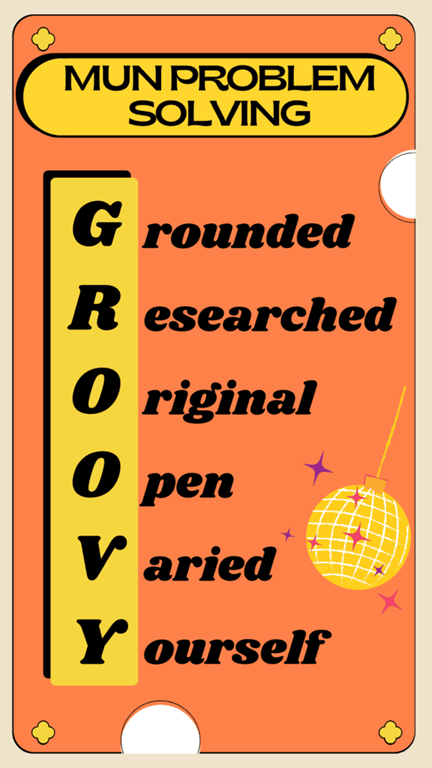
Once you've passed the GROOVY test, it's time to go deeper.
The Policy-making Process
From here, the policy-making process works in 2 steps:

Stage 1 - Feasibility Analysis
1. Clarify Your Objective
Imagine you have the following idea: increasing educational access in rural regions via digital tools. Your focus sentence could be:
“Our goal is to provide reliable online learning resources to remote schools, thereby boosting literacy rates and job prospects.”
Next, define the scope: is this a global initiative or a pilot program limited to a specific region?
You can really choose either scope, a global initiative could be exciting and get more delegations involved, and a pilot project targeting low-income rural communities in your country keeps the proposal realistic and easier to execute.
If you run into problems, you can adjust the scope later on. But it's useful to have a starting point.
2. Develop Your Approach
Once your objective is crystal-clear, shift to the “how” of your policy proposal—this is the true core of any resolution. In Model UN, the “why” is often emphasized in speeches and the preambulatory clauses, but the most practical and impactful part is the implementation.
Here are a few different guiding questions that will help shape the “how”:
- What specific programs, agencies, or committees will be responsible for enacting this policy?
- What is the immediate timeline for rolling out your proposal?
- Where will the money for this initiative come from (UN budget, donations, private sector partnerships, etc.)?
- Will it occur in stages (e.g., pilot programs, regional rollouts, then global expansion)?
- How will the proposed measures be integrated into current frameworks or treaties?
3. Consider Any Counterarguments
A good idea only succeeds if it can take the heat. The three most common counterarguments to consider are:
- Political Opposition
- Financial Opposition
- Social/Cultural Opposition
We'll consider these challenges with our original example to: "provide reliable online learning resources to remote schools, thereby boosting literacy rates and job prospects.”
Political Opposition
Some countries might not trust that a resolution has their best interests at heart. For example, countries might fear that new remote learning technology could spread foreign ideologies.
In our example, we could try and address those concerns by offering transparent oversight or by demonstrating cost-effective measures, like training local teachers to maintain equipment instead of outsourcing tech support.
Financial Opposition
No delegation wants to implement a project that might end up costing them too much money.
From a financial standpoint, outline practical solutions: how will you cover the initial costs of hardware, software, and teacher training?
Perhaps you can secure partial funding from international lenders like the World Bank, partner with local NGOs for on-the-ground training, and invite voluntary contributions from wealthier states. Presenting a clear implementation roadmap—phasing in one province first, then scaling up based on early successes—shows you’ve thought about long-term sustainability.
Social and cultural Opposition
Some delegations might have cultural differences from your own.
In our example, in traditional societies, introducing tablets or laptops might be perceived as intrusive. Tailor your plan by including local languages in digital curricula and involving community leaders in outreach.
If opposition remains, go back to your scope, and propose incremental steps (like smaller pilot programs) to showcase the benefits before rolling out the initiative more broadly.
Classic Strategies to Overcome Opposition
As you could see in our worked example, we relied on 3 classic strategies to overcome opposition, you can use these as well in your own committee.
- Gradual Roll-Out:
- Start small (pilot programs) and scale up, allowing you to showcase early successes.
- Incentives & Compromises:
- Offer benefits to hesitant delegations to gain their backing (e.g., technical assistance, co-investment opportunities).
- Relationship Building:
- Even a brilliant idea may stall without allies. Networking and courtesy toward other delegates can make a huge difference.
4. How Will You Evaluate Success?
Qualitative and quantitative measures:
What kind of data is needed to assess the effectiveness of the solution? Qualitative measures could include interviews or expert opinions, while quantitative data might involve metrics like economic impact, environmental health, or public health improvements.
What Metrics or Indicators Could Be Used to Assess Progress?
Specific, measurable indicators: What are the key performance indicators (KPIs) for success? These might include:
- For environmental issues: reduction in carbon emissions, increase in renewable energy adoption.
- For social issues: rates of poverty reduction, education access, or health outcomes.
Stage 2 - Marketing Your Policy Proposals
By this point, you should have a pretty well thought-out policy proposal. Now it's time to market it!
Marketing your proposals is just as crucial as coming up with effective proposals —because no matter how great your ideas are, they won’t make an impact if nobody remembers or understands them.
Here are a few techniques that can help you:
- Keep it simple - With Model UN, sometimes its easy to go too far and just make your solutions as elaborate and convoluted as possible. But when making your position paper you don’t have that much space to make your point. It can be much easier to make your point with a few well thought-out solutions.
- Use an acronym - bringing your initiative under the umbrella of an acronym can help your chair to remember it when they read your position paper and can link a certain problem solving approach to your delegation.
- Identify your marquee solution - If an acronym doesn’t suit, try and figure out the one idea that any delegate will be able to remember you by and will recognize as yours when it comes to the resolution writing phase.
- If you’re going to stand by it, make sure that it is a well thought out and effective solution. It can also help you with future solutions as delegates will recognize you as a competent problem-solver.

Creativity Matters
Innovative, well-researched proposals not only catch attention but can also increase your chances of winning an award.
Build on your ideas by stepping outside your comfort zone and crafting an approach that is cost-effective, realistic, and imaginative.
Whether it’s using vertical farming to combat urban hunger, harnessing solar microgrids for remote regions, or improving water purification with new filtration technologies, combining known strategies with fresh thinking can lead to impactful proposals.
This idea can be very successful in MUN, it produces well-rounded solutions that resonate with delegates.
When backed by serious research, these creative ideas stand out, helping you gain support and demonstrate your delegation’s dedication to finding forward-looking, effective solutions.
Conclusion
In conclusion, crafting effective policy proposals is a journey that starts with solid research and ends with creative, actionable solutions that resonate with other delegates.
By using tools like the GROOVY framework, conducting feasibility analyses, and considering counterarguments, you can ensure your ideas are both practical and impactful. Marketing your proposals and bringing in a bit of creativity further amplifies their influence, making them memorable and more likely to gain support.
Up next, we're covering how to write about all of your policy proposals in your position paper.



